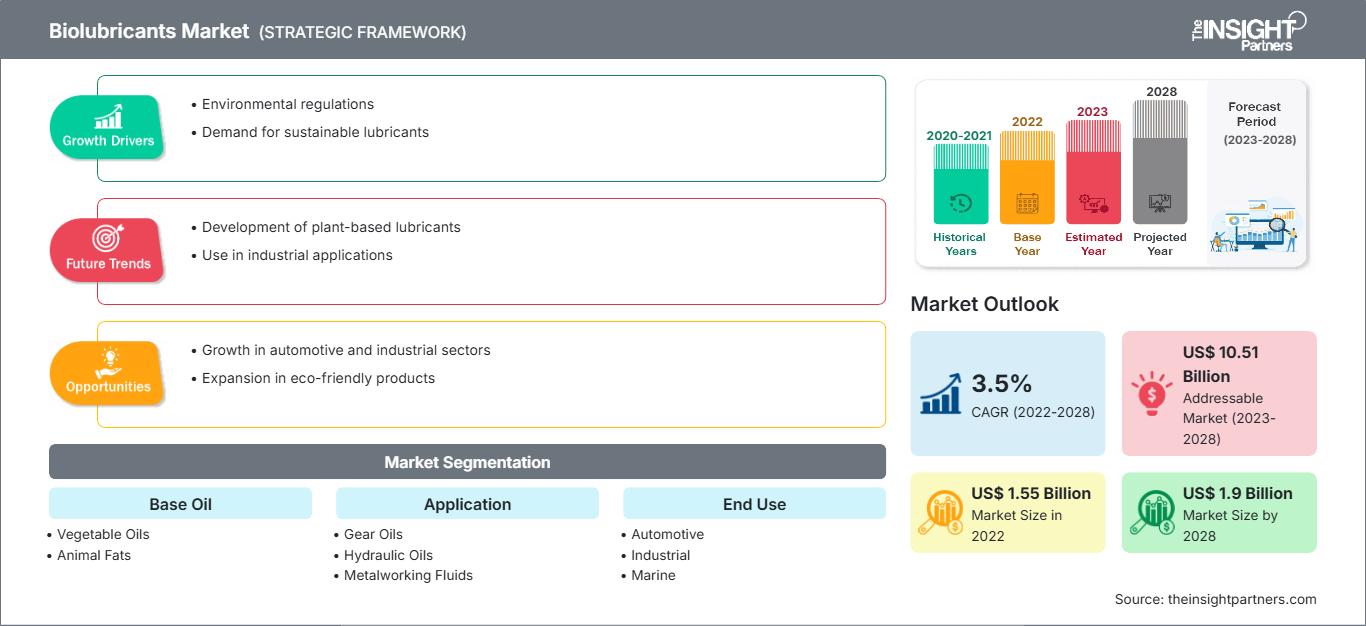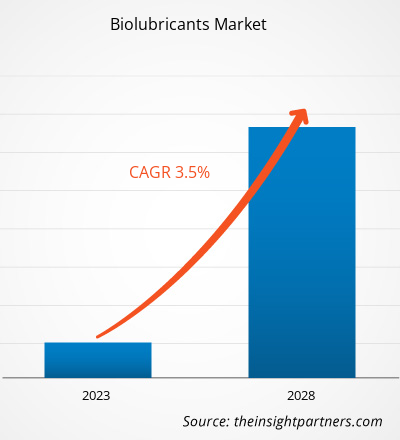바이오 윤활제 시장은 2022년 15억 5,115만 달러에서 2028년 19억 241만 달러로 성장할 것으로 예상되며, 2022년부터 2028년까지 연평균 3.5% 성장할 것으로 예상됩니다.
바이오 윤활제는 식물성 오일과 동물성 제품을 포함한 기타 재생 가능 자원에서 추출한 오일로 만들어집니다. 바이오 윤활제는 생분해성이 있으며 인간과 수생 환경에 무독성입니다. 바이오 윤활제의 생분해성은 환경으로 누출될 위험이 높은 응용 분야에서 중요한 역할을 합니다. 또한, 바이오 윤활제는 인화점이 높고 점도가 일정하며 오일 미스트/증기 배출이 적어 안전성이 향상됩니다. 또한, 배출물이 적고 금속 표면에 대한 접착력이 우수합니다. 바이오 윤활제는 엔진, 기어박스, 유압 장치, 전기톱, 그리스, 2행정 쾌속정 엔진 등 다양한 분야에 사용됩니다. 바이오 윤활제는 자동차, 해양, 농업 및 임업, 광업, 건설, 전력 전송, 식품, 제약 등 다양한 최종 사용 산업에서 널리 사용됩니다.
바이오 윤활제 시장 성장은 환경 의식 제고, 환경 친화적인 윤활제 사용을 의무화하는 엄격한 환경법, 그리고 기존 난분해성 윤활제의 높은 폐기 비용으로 인해 다양한 최종 사용 산업에서 바이오 윤활제에 대한 수요가 증가한 데 기인합니다. 많은 국가에서 내륙 수로 주변에서 미네랄 오일 기반 윤활제 사용을 금지하는 규정이 있습니다. 이러한 규정은 다양한 응용 분야에서 바이오 윤활제 수요를 촉진하고 있습니다. 또한, 바이오 윤활제는 깨끗하고 무독성이기 때문에 전 세계 일부 국가에서 임업 및 해양과 같이 매우 민감한 분야에서 사용이 의무화되었습니다. 해양 분야에서 바이오 윤활제는 컨테이너, 화물선, 유조선 및 기타 선박의 다양한 섹션과 공정에서 윤활 목적으로 사용됩니다. 해양 바이오 윤활제는 엔진 오일, 유압 오일, 압축기 오일, 슬라이드웨이 오일, 기어 오일, 열전달 오일, 그리스, 터빈 오일 등으로 구성됩니다. 또한, 세계 해상 무역 성장은 높은 효율과 낮은 배출 용량을 갖춘 바이오 윤활제에 대한 수요를 촉진했습니다. 따라서 해양 산업에서 바이오 윤활제 사용 증가는 예측 기간 동안 바이오 윤활제 시장에 수익성 있는 기회를 제공할 것입니다.
요구 사항에 맞게 이 보고서를 사용자 정의하십시오.
이 보고서의 일부, 국가 수준 분석, Excel 데이터 팩을 포함하여 모든 보고서에 대한 사용자 정의를 무료로 받을 수 있을 뿐만 아니라 스타트업 및 대학을 위한 훌륭한 제안 및 할인을 이용할 수 있습니다
바이오 윤활제 시장: 전략적 통찰력

- 이 보고서의 주요 주요 시장 동향을 확인하세요.이 무료 샘플에는 시장 동향부터 추정 및 예측에 이르기까지 데이터 분석이 포함됩니다.
이 보고서의 일부, 국가 수준 분석, Excel 데이터 팩을 포함하여 모든 보고서에 대한 사용자 정의를 무료로 받을 수 있을 뿐만 아니라 스타트업 및 대학을 위한 훌륭한 제안 및 할인을 이용할 수 있습니다
바이오 윤활제 시장: 전략적 통찰력

- 이 보고서의 주요 주요 시장 동향을 확인하세요.이 무료 샘플에는 시장 동향부터 추정 및 예측에 이르기까지 데이터 분석이 포함됩니다.
시장 분석
자동차 산업 수요 증가로 바이오 윤활제 시장 성장 견인
엔진 오일, 변속기 오일, 기어박스 오일, 브레이크 오일, 유압 오일, 그리고 기타 자동차 오일은 자동차 및 운송 산업에서 사용됩니다. 바이오 윤활제는 마찰 방지 및 열 흡수 매체로 사용되어 원활하고 안정적인 기능/작동을 보장하고, 잦은 고장 위험을 줄여 차량의 내구성/수명 주기를 향상시킵니다. 자동차 윤활제는 마찰을 줄이고 두 표면이 서로 접촉할 때 발생하는 열을 완화하는 데 사용됩니다. 또한, 바이오 기반 엔진 오일은 높은 고유 생분해율, 낮은 수생 생물 독성, 그리고 매우 낮은 생물 축적률을 보입니다. 더 나아가, 탄화수소 기반 오일을 생분해성 제품으로 대체하는 것은 윤활제가 생태계에 미치는 악영향을 줄이는 방법 중 하나입니다. 차량 연비 향상 및 온실가스 배출 감축에 대한 규제 압력이 커짐에 따라 오일 윤활제 제형이 괄목할 만한 발전을 이루었습니다. 이러한 요인들이 자동차 산업에서 바이오 윤활제에 대한 수요를 증가시키고 있습니다.
기유 분석
바이오 윤활제 시장은 기유를 기준으로 식물성 오일, 동물성 지방 등으로 구분됩니다. 식물성 오일 부문은 2022년 시장 점유율 1위를 차지했습니다. 식물성 오일은 높은 점도, 높은 비등점 범위, 생분해성 등의 고유한 특성으로 인해 윤활제 기유(base stock)에서 미네랄 오일보다 선호되는 대안입니다. 식물성 오일의 지방산은 화학적으로 변형되어 고분자량 에스테르를 형성할 수 있으며, 이는 기존 미네랄 오일 기반 윤활제를 대체할 수 있습니다. 이러한 요인들이 식물성 오일 부문 시장 성장을 견인할 것으로 예상됩니다.
EmeryOleochemicals LLC, Fuchs Petrolub SE, Carl Bechem GmbH, PANOLIN AG, Renewable Lubricants Inc, TotalEnergies SE, Shell Plc, RSC Bio Solutions LLC, Crevier Group Inc, Kluber Lubrication GmbH & Co KG는 바이오 윤활제 시장의 주요 기업입니다. 주요 기업들은 인수합병 및 제품 출시와 같은 전략을 통해 지역적 입지와 고객 기반을 확대하고 있습니다.
생물윤활유 시장 지역별 통찰력
The Insight Partners의 분석가들은 예측 기간 동안 바이오 윤활제 시장에 영향을 미치는 지역별 동향과 요인들을 면밀히 분석했습니다. 이 섹션에서는 북미, 유럽, 아시아 태평양, 중동 및 아프리카, 그리고 중남미 지역의 바이오 윤활제 시장 부문 및 지역별 현황도 다룹니다.
생물윤활유 시장 보고서 범위
| 보고서 속성 | 세부 |
|---|---|
| 시장 규모 2022 | US$ 1.55 Billion |
| 시장규모별 2028 | US$ 1.9 Billion |
| 글로벌 CAGR (2022 - 2028) | 3.5% |
| 이전 데이터 | 2020-2021 |
| 예측 기간 | 2023-2028 |
| 다루는 세그먼트 |
By 기유
|
| 포함된 지역 및 국가 | 북미
|
| 시장 선도 기업 및 주요 회사 프로필 |
|
생물윤활유 시장 참여자 밀도: 비즈니스 역학에 미치는 영향 이해
바이오 윤활제 시장은 소비자 선호도 변화, 기술 발전, 그리고 제품의 이점에 대한 인식 제고 등의 요인으로 인한 최종 사용자 수요 증가에 힘입어 빠르게 성장하고 있습니다. 수요가 증가함에 따라 기업들은 제품 라인업을 확장하고, 소비자 니즈를 충족하기 위한 혁신을 추진하며, 새로운 트렌드를 적극 활용하고 있으며, 이는 시장 성장을 더욱 가속화하고 있습니다.

- 을 얻으세요 바이오 윤활제 시장 주요 주요 플레이어 개요
보고서 스포트라이트
- 생물 윤활제 산업의 진보적 추세는 플레이어가 효과적인 장기 전략을 개발하는 데 도움이 됩니다.
- 선진 및 개발도상 시장에서 성장을 확보하기 위해 회사가 채택한 사업 성장 전략
- 2020년부터 2028년까지 글로벌 생물 윤활제 시장에 대한 정량적 분석
- 다양한 산업에서 생물 윤활제에 대한 수요 추정
- 생물 윤활제 산업에서 운영하는 구매자와 공급업체의 효율성을 보여주기 위한 포터의 5가지 힘 분석
- 경쟁 시장 시나리오와 생물 윤활제 수요를 이해하기 위한 최근 개발
- 시장 추세 및 전망, 그리고 생물 윤활제 시장 성장을 지배하는 요인
- 시장 성장에 대한 상업적 관심을 뒷받침하고 의사 결정 프로세스를 돕는 계몽적인 전략
- 다양한 시장 노드에서의 생물 윤활제 시장 규모
- 생물 윤활제 시장에 대한 자세한 개요 및 세분화 바이오 윤활제 시장 규모와 산업 역학
- 성장 가능성이 유망한 다양한 지역의 바이오 윤활제 시장 규모
"2028년까지의 바이오 윤활제 시장 전망"은 바이오 윤활제 시장 동향 분석에 중점을 둔 화학 및 소재 산업에 대한 전문적이고 심층적인 연구입니다. 이 보고서는 상세한 세분화를 통해 시장 개요를 제공하는 것을 목표로 합니다. 바이오 윤활제 시장은 기유, 응용 분야, 최종 용도 및 지역을 기준으로 세분화됩니다. 기유를 기준으로 시장은 식물성 오일, 동물성 지방 등으로 세분화됩니다. 응용 분야를 기준으로 시장은 기어 오일, 유압 오일, 금속 가공 유체, 그리스 등으로 세분화됩니다. 최종 용도를 기준으로 시장은 자동차, 산업, 해양, 농업 및 임업 등으로 세분화됩니다. 시장은 북미, 유럽, 아시아 태평양, 중동 및 아프리카, 중남미의 5개 주요 지역으로 세분화됩니다. 2022년에는 유럽이 바이오 윤활제 시장을 장악했습니다. 아시아 태평양 지역은 예측 기간 동안 가장 높은 연평균 성장률(CAGR)을 기록할 것으로 예상됩니다. 환경 문제 심화 및 원유 가격 상승 등의 요인이 유럽의 바이오 윤활제 수요를 견인하고 있습니다. 아시아 태평양 지역의 바이오 윤활제 수요는 해당 지역의 산업화 및 자동차 생산 증가와 정비례합니다. 지역 건설 활동과 산업 및 자동차 부문의 성장은 시장 성장을 가속화하고 있습니다.
- 과거 분석(2년), 기준 연도, CAGR을 포함한 예측(7년)
- PEST 및 SWOT 분석
- 시장 규모 가치/거래량 - 글로벌, 지역, 국가
- 산업 및 경쟁 환경
- Excel 데이터세트
최근 보고서
관련 보고서
사용 후기
구매 이유
- 정보에 기반한 의사 결정
- 시장 역학 이해
- 경쟁 분석
- 고객 인사이트
- 시장 예측
- 위험 완화
- 전략 기획
- 투자 타당성 분석
- 신흥 시장 파악
- 마케팅 전략 강화
- 운영 효율성 향상
- 규제 동향에 발맞춰 대응




















 무료 샘플 받기 - 바이오 윤활제 시장
무료 샘플 받기 - 바이오 윤활제 시장